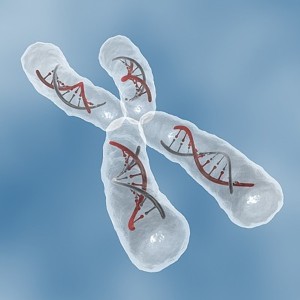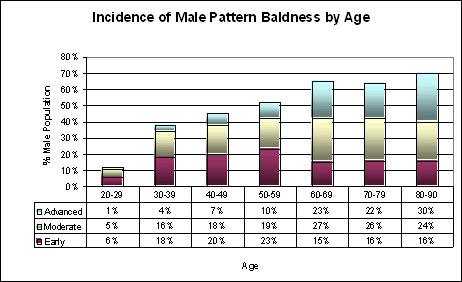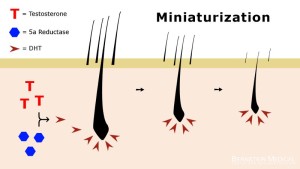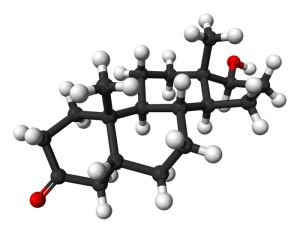The Mechanism of Male Hair Loss: DHT
Hereditary hair loss in men (androgenetic alopecia) is caused by the action of the hormone dihydrotestosterone (DHT) on genetically susceptible scalp hair follicles.
Normally, hair follicles cycle through a growth stage (anagen), which lasts 2-6 years, and a resting stage (telogen), which lasts approximately 1–4 months. However, prolonged exposure to DHT causes genetically susceptible follicles to gradually spend less time growing and more time in the resting stage. The follicles become progressively smaller, in what is called “miniaturization,” and this causes them to produce smaller and smaller hair shafts. Eventually, they stop producing hairs completely, leaving a bald area.
DHT-sensitive follicles normally reside in the front, top, and crown of the scalp. When a sufficient number of follicles in these areas are miniaturized, the balding exhibits an easily identifiable pattern that is described by the Norwood Classification of male hair loss. Balding typically begins with recession of the hairline at the temples and thinning of the crown. It may progress to complete baldness in the front, top, and crown of the scalp while leaving a wreath of hair around the back and sides of the scalp. This area, which consists of large numbers of DHT-resistant follicles, is often referred to as the “permanent zone.”
Balding: Genes, Hormones & Age
While the cause of androgenetic hair loss is the same for all men (i.e., men whose hair loss is not caused by an underlying medical condition, drugs, or stress), there is significant variation in the age at which men start to go bald, as well as the extent of their balding. This wide variability is due to the fact that the expression of androgenetic hair loss is significantly affected by three related factors: genes, hormones, and age.
Let us explore each of these important contributors to male hair loss.
Genes in Hair Loss
Many people have heard that “hair loss comes from the mother’s side of the family,” but this is largely a myth: while there is a slightly higher frequency of inheritance from the mother’s side, male pattern hair loss is a genetic trait that can be inherited from either parent. Research suggests that it is a polygenic trait, involving more than one gene, and it is much more complicated than originally thought.
A little background on genetics: a gene is one small part of the chemically encoded hereditary instruction manual that consists of 23 different pairs of chromosomes. It is found in every cell of our body. Twenty-two of the pairs are called “autosomes” and the 23rd pair is a pair of sex chromosomes (the X or Y chromosome). In men, the sex chromosomes include an X chromosome and a Y chromosome, while in women the pair consists of two X chromosomes. These genetic instructions control everything from the development of a fetus to the color of your eyes. Genes may be “dominant,” in that the gene only needs to be present in one chromosome of a pair for the trait to show up, or “recessive,” in which the gene must be present in both chromosomes for that gene to be activated or “expressed.” The most important genes involved in androgenetic alopecia are felt to be dominant ones. It is felt that the genes governing common baldness are both sex-linked and autosomal.
 An important androgen receptor gene is located on the X chromosome
An important androgen receptor gene is located on the X chromosomeInheritance from the maternal side of the family may be slightly more common due to the presence of an important androgen receptor gene (AR) on the X chromosome. The Y chromosome is not believed to contain any genes that affect hair loss. Inheritance from the father’s side would be explained by the presence of an autosomal (non-sex) gene, but this gene has yet to be discovered.
Complicating the issue further, just having the genes for baldness in your genetic makeup, does not guarantee that the trait will manifest. The baldness genes need to be “turned on” or “expressed” in order for androgenetic alopecia to be apparent. Gene expression is related to a number of factors, the major ones being hormones and age, although stress and other factors can contribute to hair loss in some individuals.
It is of interest that, although genes for some types of hair loss have been mapped, the genes responsible for male pattern baldness have yet to be fully identified. This suggests that any kind of genetic engineering to prevent common baldness is still many, many years away.
In summary, Androgenetic alopecia is felt to be a “dominant” genetic trait that is passed down from your mother or father, but with a slight predisposition to the maternal side due to the presence of an important androgen receptor gene on the X chromosome. In order for hair loss to become apparent, the trait must be expressed – through changes in the production of hormones or changes due to the aging process.
Hormones in Hair Loss
Hormones are biochemical substances produced by various glands located throughout the body. These glands secrete hormones directly into the bloodstream, spreading the chemicals throughout the body. Hormones are very powerful; minute amounts can have profound effects on your body.
Testosterone, the major male sex hormone, and other hormones that have masculinizing effects are made primarily in the testicles. It is not until after the testicles develop and enlarge during puberty that hormones can reach a level in the bloodstream sufficient to commence the balding process. In addition to the testicles, the adrenal glands, located above each kidney in men and women, produce androgenic hormones. In females, the ovaries are an additional source of hormones that can affect hair growth.
The hormone felt to be directly involved in androgenetic alopecia is a derivative of testosterone called dihydrotestosterone (DHT). DHT, formed by the action of the enzyme 5-a reductase on testosterone, binds to special receptor sites on the cells of genetically susceptible hair follicles causing miniaturization and eventual balding. (See the Miniaturization graphic).
In men, 5-a reductase activity is higher in the balding area, which leads to the development of patterned hair loss. It typically begins with a recession of the hairline and temples and/or thinning in the crown. It can start as early as adolescence or it can appear later in life. 5-alpha reductase Type II, the predominant form in hair follicles, is blocked by the hair loss medication finasteride (Propecia). The chemical finasteride binds to 5-alpha reductase molecules, preventing them from converting testosterone into DHT. The resulting decrease in the concentration of DHT results in the halting or reversal of the miniaturization process.
It is interesting to consider that while scalp hair growth is not dependent on androgens, scalp hair loss is androgen dependent.
Age in Hair Loss
 Incidence of Male Pattern Baldness by Age ((Norwood, O.T. Senile alopecia, in Hair Transplant Surgery, 2nd ed., O.T. Norwood, R. Shiell, eds.))
Incidence of Male Pattern Baldness by Age ((Norwood, O.T. Senile alopecia, in Hair Transplant Surgery, 2nd ed., O.T. Norwood, R. Shiell, eds.))Genes and hormones are not sufficient on their own to cause baldness. Even after a person has reached puberty, susceptible hair follicles must continually be exposed to DHT over time for hair loss to occur. The age at which these effects manifest varies from one individual to another and is related to a person’s genetic composition, the level of testosterone in the bloodstream, and the follicular sensitivity to the hormone.
Additionally, male hair loss does not occur all at once or in a steady, straight-line progression. Instead, it is characteristically irregular, with people losing their hair in alternating periods of slow and rapid hair loss, interspersed with periods of stability. The reasons that hair loss rates speed up and slow down are unknown, but we do know that with age, a person’s total hair volume will gradually decrease.
Even when there is no predisposition to genetic balding, as a man ages, some hairs in each follicular unit randomly begin to miniaturize. As a result, each group will contain both full terminal hairs and miniaturized hairs, making the area appear less full. Eventually, the miniaturized hairs are lost and the follicular units are reduced in number. In all adult patients, the entire scalp undergoes this aging process so that even the “Permanent Zone” is not truly permanent but will gradually thin, to some degree, over time. Fortunately, in most men, the permanent zone retains enough permanent hair so that hair transplantation remains a viable option for men well into their 70s.







